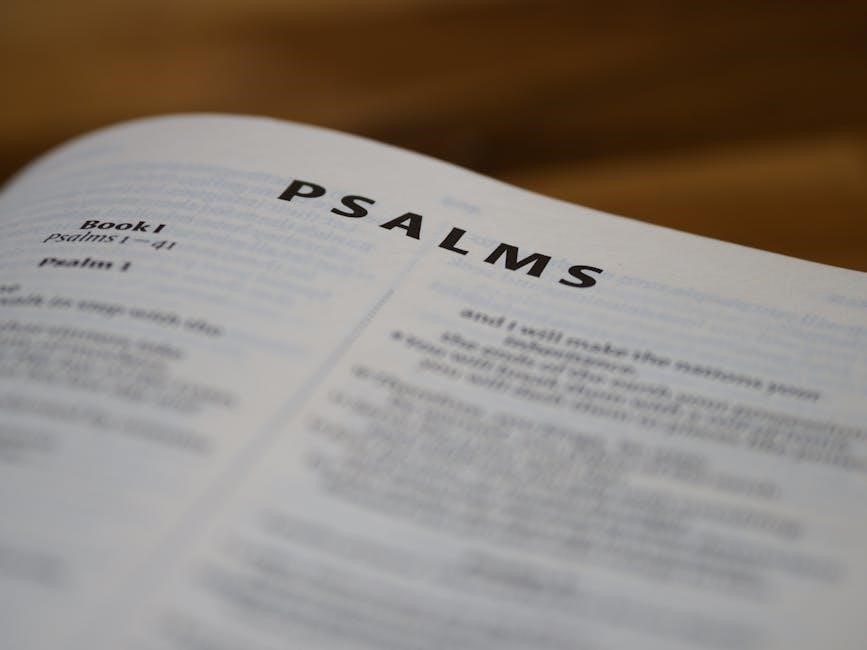
The Psalms PDF is a digital version of the Book of Psalms, offering Hebrew and English translations for easy access and study, ideal for personal devotion and worship.
1.1 Overview of the Book of Psalms
The Book of Psalms, a sacred collection of poems and songs, is the longest book in the Bible, comprising 150 psalms. These compositions reflect a wide range of human emotions, spiritual struggles, and divine praises, offering insights into faith, hope, and redemption. Authored by various individuals, including King David, Asaph, and Solomon, over several centuries, the psalms serve as a timeless resource for worship, meditation, and guidance. Their diverse themes and poetic styles make them universally relatable, bridging ancient and modern spiritual experiences.
1.2 Importance of Psalms in Religious Texts
The Psalms hold a central place in religious texts, serving as a foundational source of spiritual guidance, worship, and comfort. They express deep human emotions, from joy and gratitude to sorrow and despair, offering solace and inspiration. As poetic prayers, they bridge the divine and human, making them a cornerstone of liturgy and personal devotion. Their timeless relevance and universal themes have made them indispensable in faith traditions, fostering connection with the divine and enriching spiritual journeys across generations.
1.3 Availability of Psalms in Digital Formats
The Psalms are widely available in digital formats, including PDFs, making them easily accessible for modern readers. Many religious websites, e-bookstores, and apps offer downloadable versions, often for free or at minimal cost. These digital editions are convenient, allowing users to carry the entire book on their devices. Features like searchable text and bookmarks enhance usability, while compatibility with smartphones, tablets, and computers ensures accessibility. This digital accessibility has revolutionized how people engage with the Psalms, fostering deeper study and reflection in today’s tech-driven world.

Structure and Composition of the Psalms
The Psalms are structured into five books, with King David as the primary author, featuring diverse poetic styles and themes that reflect deep spiritual and emotional expression.
2.1 Division into Five Sections
The Psalms are organized into five distinct sections, mirroring the five books of Moses. Each section concludes with a doxology, creating a structured framework for worship and reflection. The first book (Psalms 1-41) focuses on personal devotion, while the second (Psalms 42-72) emphasizes communal prayer. The third (Psalms 73-89) reflects on Israel’s history, the fourth (Psalms 90-106) on God’s sovereignty, and the fifth (Psalms 107-150) on praise and redemption. This division enhances thematic progression, making the Psalms accessible for both individual and communal use in PDF formats.
2.2 Role of King David as a Prominent Author
King David is traditionally credited as the author of many Psalms, with at least 73 attributed to him. His writings reflect his deep spiritual insight, emotional honesty, and leadership experiences. David’s Psalms span a wide range of emotions, from joy and praise to repentance and despair, offering readers a profound connection to his faith journey. His contributions form a significant part of the Psalms PDF, making him a central figure in its composition and spiritual resonance.
2.3 Varieties of Themes and Emotions
The Psalms PDF encompasses a vast array of themes and emotions, making it a deeply relatable and universal text. Themes include worship, lament, wisdom, and thanksgiving, while emotions range from joy and hope to anger and sorrow. This diversity reflects the complexity of human experiences, offering comfort and inspiration across various life circumstances. The Psalms’ emotional depth resonates with readers, making them a rich source for personal reflection and communal worship.

Themes and Emotions in Psalms
The Psalms PDF explores diverse themes like worship, praise, and thanksgiving, alongside lamentations and spiritual struggles, offering deep emotional resonance and connection to human experiences.
3.1 Worship, Praise, and Thanksgiving
The Psalms PDF highlights the central role of worship, praise, and thanksgiving in expressing devotion to God. Many psalms are directed toward communal worship, encouraging believers to sing, play instruments, and offer sacrifices of thanksgiving. Themes of gratitude are woven throughout, acknowledging God’s sovereignty, faithfulness, and mercy. Psalms like Psalm 100 exemplify this, calling people to enter God’s presence with joy and thanksgiving. These expressions of worship and praise serve as a foundation for spiritual connection and communal celebration, reflecting the profound emotional and theological depth of the Psalms.
3.2 Lamentations and Spiritual Struggles
The Psalms PDF reveals the profound expression of lamentations and spiritual struggles, reflecting human frailty and the quest for divine comfort. Many psalms voice deep emotional pain, such as feelings of abandonment, injustice, or personal sin. Psalms like 51 and 38 openly express sorrow and repentance, seeking God’s mercy and restoration. These laments serve as a bridge between human suffering and divine hope, offering solace and reaffirming trust in God’s faithfulness amidst life’s challenges and uncertainties.
3.4 Connection to Human Experiences and Faith
The Psalms PDF deeply resonates with universal human experiences, bridging the gap between personal faith and real-life struggles. Themes of hope, trust, and divine providence are woven throughout, offering comfort and guidance. Psalms like 23 and 138 exemplify this connection, providing reassurance in times of uncertainty and celebrating God’s faithfulness. This timeless relevance allows readers to find solace and strength, making the Psalms a cornerstone of spiritual reflection and growth across generations and cultures.

Translations and Versions of Psalms
The Psalms PDF is available in numerous translations, including Hebrew, English, Greek, and Latin, ensuring accessibility across languages and cultural contexts for deeper spiritual engagement.
4.1 Hebrew and English Translations
The Psalms were originally written in Hebrew, with its poetic structure and imagery preserved through careful translation into English. The Hebrew text serves as the foundational source, while English versions like the King James Version (KJV) and New International Version (NIV) provide accessible interpretations. These translations maintain the spiritual depth and emotional resonance of the original, ensuring the Psalms remain relevant for modern readers. The interplay between Hebrew and English translations allows for a richer understanding of the text, blending historical accuracy with contemporary readability.
4.2 Early Editions and Publications
The Psalms have a rich history of early printed editions, beginning with the Gutenberg Bible in the 15th century. The first English translation by John Wycliffe in 1382 laid the groundwork for later versions. The Geneva Bible of 1560 and the Book of Common Prayer further popularized the Psalms, making them accessible to a broader audience. These early publications played a crucial role in standardizing the text and facilitating its widespread use in worship and personal devotion.
4.3 Translations into Other Languages
The Psalms have been translated into numerous languages, ensuring their universal accessibility. Early translations include the Latin Vulgate, which played a central role in Christian liturgy. In the Reformation era, translations like Luther’s German Psalter further expanded their reach. Today, the Psalms are available in Spanish, French, Chinese, and many other languages, enabling diverse cultures to connect with their timeless message. These translations preserve the original meaning while adapting to linguistic and cultural contexts, ensuring the Psalms remain relevant across the globe.

Early Editions and Publications of Psalms
The Psalms were first published in early printed formats, with notable editions like the Bay Psalm Book, marking significant milestones in religious and literary history.
5.1 Historical Significance of Early Prints
The early printed editions of Psalms hold immense historical value, reflecting the evolution of religious texts in print. The Bay Psalm Book, published in 1640, was the first book printed in North America, showcasing the Psalms’ central role in early colonial spirituality. These early prints preserved sacred poetry and facilitated widespread dissemination, influencing religious practices and literacy. They also bridged oral traditions with written formats, making the Psalms accessible to broader audiences and fostering a deeper connection to faith and culture across generations.
5.2 The Bay Psalm Book and Its Importance
The Bay Psalm Book, printed in 1640, is the first book published in North America and a landmark in religious publishing. It contains Psalms translated into English by Puritan ministers, reflecting their theological beliefs. This historic text is a rare artifact, with only 11 copies remaining, making it highly valuable to collectors and historians. It symbolizes the enduring influence of Psalms in shaping colonial spirituality and the early American literary tradition, connecting faith and culture across centuries.
5.3 Contributions of Translators like T. Sternhold and J. Hopkins
Thomas Sternhold and John Hopkins played pivotal roles in translating Psalms into English, creating the influential Sternhold and Hopkins Psalter. Their work, first published in 1547, made Psalms accessible to English-speaking congregations, blending poetic expression with religious devotion. Their translations became foundational for Protestant worship, emphasizing congregational singing and spiritual engagement. Despite later revisions, their contributions remain significant, shaping the linguistic and musical traditions of Psalms in English-speaking cultures for centuries.

Poetic Structure and Style of Psalms
The Psalms exhibit a rich poetic structure, utilizing parallelism, imagery, and climactic arrangements to convey deep emotions and spiritual truths. Their lyrical style enhances worship and reflection.
6.1 Use of Parallelism and Imagery
The Psalms employ parallelism, where phrases mirror each other for emphasis, and vivid imagery to convey spiritual truths. This structure enhances themes of praise, lament, and hope, making them relatable and profound.
6.2 Climactic Structure in Psalms
The Psalms often feature a climactic structure, where ideas or emotions build toward a peak, emphasizing key messages. This pattern starts with a problem or situation, progresses through expressions of hope or struggle, and culminates in a resolution or exaltation of God. Such a structure engages readers emotionally and intellectually, reinforcing the spiritual themes and providing a sense of progression and fulfillment in prayer and worship.
6.3 Musical and Liturgical Use
The Psalms have long been integral to worship, often set to music for liturgical use. Many Psalms were originally composed as hymns or songs, with poetic structures lending themselves to chanting or singing. Across cultures, they’ve been adapted into various musical forms, from Gregorian chants to modern hymns. Their rhythmic and lyrical nature enhances communal worship, making them a cornerstone of religious services. This musical dimension not only preserves their spiritual essence but also ensures their relevance in diverse liturgical traditions, fostering a deep connection with faith communities.

Downloading and Accessing Psalms PDF
The Psalms PDF can be downloaded from various religious websites, digital libraries, and platforms like Google Books. Many sources offer free access for personal or communal use.
7.1 Popular Platforms for Download
Popular platforms for downloading Psalms PDF include Google Books, Amazon, and religious websites like BibleGateway or YouVersion. These platforms offer free or paid versions, often with searchable text. Many churches and religious organizations provide downloadable Psalms PDFs for congregational use. Additionally, sites like Project Gutenberg and Internet Archive host public-domain editions. Some platforms also offer annotated or study versions, enhancing the reader’s experience. These resources ensure easy access to the Psalms for personal study, worship, or educational purposes, catering to diverse needs and preferences.
7.2 Features of Psalms PDFs (Searchable Text, Bookmarks)
Psalms PDFs often include features like searchable text, allowing users to quickly locate specific verses or keywords. Bookmarks enable easy navigation through chapters or sections, enhancing accessibility. Many PDFs also feature hyperlinked indexes, facilitating quick jumps to desired psalms. Additional functionalities may include highlighting, annotations, and adjustable font sizes for readability. These features make Psalms PDFs versatile tools for personal study, sermon preparation, or group worship. They ensure a seamless and efficient experience for readers engaging with the text.
7.3 Free Resources and Libraries
Accessing Psalms PDFs is made easier through free resources and libraries. Many religious and educational institutions offer downloadable versions of the Psalms at no cost. Websites like Project Gutenberg and Archive.org provide public-domain editions of the Psalms in PDF format. Additionally, some religious organizations and publishers offer complimentary Psalms PDFs for personal or educational use. These resources are often designed to be easily accessible and shareable, making it convenient for individuals to study or reference the Psalms digitally without financial barriers.

Cultural and Religious Significance of Psalms
The Psalms hold profound cultural and religious significance, serving as a cornerstone of worship and spiritual reflection in both Jewish and Christian traditions for centuries.
8.1 Role in Jewish and Christian Liturgy
The Psalms play a central role in both Jewish and Christian liturgy, serving as a foundational text for worship, prayer, and communal devotion. In Jewish tradition, Psalms are integral to daily prayers and special services, often recited or chanted in synagogues. Similarly, in Christianity, Psalms are used in liturgical practices, hymns, and responsive readings across denominations. Their universal themes of praise, lament, and faith resonate deeply, making them a shared spiritual resource that bridges traditions and fosters unity among diverse congregations.
8.2 Influence on Prayer and Worship
The Psalms have profoundly shaped prayer and worship practices across centuries, offering expressions of praise, confession, and thanksgiving. Their poetic and musical structure has inspired countless hymns and liturgical chants. In both personal and communal worship, Psalms provide a divine vocabulary for human emotions, connecting believers to God’s presence. Their adaptability across cultures and languages has made them a universal resource for spiritual expression, enriching worship traditions and deepening devotional lives for millions around the world.
8.3 Connection to Spiritual Growth and Reflection
The Psalms deeply nurture spiritual growth by offering insights into human experiences and divine truths. They provide comfort, guidance, and encouragement, fostering personal reflection and intimacy with God. Through their rich imagery and heartfelt prayers, the Psalms help believers navigate life’s joys and challenges, cultivating a deeper faith and trust in God’s sovereignty. This timeless collection remains a vital tool for meditation, inspiring seekers to align their hearts with God’s will and find transformative grace in their spiritual journeys.
Analyzing Specific Psalms
Exploring specific Psalms reveals their unique theological and emotional depth, offering insights into their historical contexts and spiritual significance for personal and communal worship.
9.1 Psalm 8: Structure and Meaning
Psalm 8 is a poetic hymn that reflects on God’s majesty and humanity’s place in creation. It begins and ends with “O Lord, our Lord,” emphasizing divine sovereignty. The psalm explores themes of wonder, praise, and the dignity of humanity, highlighting God’s handiwork in creation. Its structure is symmetrical, with a focus on the heavens and earth, symbolizing cosmic order. Theologically, it balances God’s transcendence with His concern for humanity, offering insights into faith and stewardship. This psalm is often studied for its rich imagery and profound theological implications.
9.2 Psalm 18: Historical and Spiritual Context
Psalm 18, attributed to King David, is a triumphant declaration of trust and praise after divine deliverance. Historically, it mirrors 2 Samuel 22, reflecting David’s experiences of persecution and rescue. Spiritually, it underscores God’s faithfulness and the psalmist’s unwavering reliance on Him. The psalm is structured to recount distress, divine intervention, and gratitude, offering deep insights into the human condition and divine deliverance. Its vivid imagery and emotional depth make it a powerful text for worship and personal reflection, resonating across generations.
9.3 Other Notable Psalms and Their Significance
Beyond Psalm 18, other notable Psalms hold profound spiritual and historical value. Psalm 23, often called the “Shepherd’s Psalm,” offers comfort and assurance of God’s guidance. Psalm 51, a penitential prayer, expresses deep repentance and the desire for cleansing. Psalm 121, a traveler’s Psalm, emphasizes trust in God’s protection. Psalm 139, with its focus on divine omniscience, celebrates God’s intimate knowledge of humanity. These Psalms provide rich insights into faith, struggle, and redemption, making them essential for personal reflection and communal worship.

The Role of Technology in Accessing Psalms PDF
Technology has revolutionized access to Psalms PDF, enabling easy downloading, searchable text, and multimedia enhancements. Apps, e-readers, and online platforms now offer convenient ways to engage with Psalms digitally.
10.1 Librivox Recordings and Audio Versions
Librivox offers free public domain recordings of the Psalms, providing auditory access to these sacred texts. Volunteers narrate the verses, making them accessible to those who prefer listening or have visual impairments. These recordings complement Psalms PDFs, enabling deeper engagement through sound; Users can download or stream the audio, enhancing personal study, meditation, or group worship. This format bridges tradition with modern technology, ensuring the timeless messages of the Psalms reach a broader audience in a convenient and immersive way.
10.2 Benefits of Digital Access
Digital access to Psalms PDF offers unparalleled convenience and flexibility. Users can easily carry the text on mobile devices, accessing it anytime, anywhere. Searchable features allow quick navigation to specific verses, enhancing study efficiency. Adjustable fonts and night modes improve readability. Digital versions also enable sharing and collaboration, fostering community engagement. Additionally, hyperlinks and cross-references provide deeper insights, making the Psalms more accessible and engaging for personal reflection, worship, or scholarly research. This modern format ensures the timeless wisdom of the Psalms remains relevant and easily accessible in today’s fast-paced world.
10.3 Future Trends in Digital Religious Texts
Future trends in digital religious texts, including Psalms PDF, emphasize enhanced interactivity and accessibility. Augmented Reality (AR) and Virtual Reality (VR) may soon enable immersive experiences, bringing historical contexts to life. AI-driven tools could personalize study materials, offering tailored reflections or music based on specific Psalms. Additionally, interactive features like real-time discussions and collaborative annotations will foster deeper engagement. These innovations aim to bridge tradition with modern technology, ensuring sacred texts remain relevant and accessible to future generations.

Practical Uses of Psalms PDF
Psalms PDF offers convenience for personal reflection, group worship, and educational purposes, providing accessible, portable, and easily shareable content for spiritual growth and community engagement.
11.1 Personal Study and Meditation
The Psalms PDF is an invaluable tool for personal study and meditation, offering easy access to timeless wisdom and spiritual guidance. Its portability allows individuals to reflect on sacred verses anytime, anywhere, fostering deeper faith and introspection. Features like searchable text and bookmarks enable quick navigation to specific psalms, making it easier to tailor personal devotionals. For those seeking solace or inspiration, the PDF format provides a convenient and distraction-free way to engage with the Word, enhancing moments of quiet contemplation and prayer.
11.2 Group Worship and Community Engagement
The Psalms PDF is a powerful resource for group worship and community engagement, enabling shared spiritual experiences. Its digital format allows easy distribution among congregation members, ensuring everyone can follow along during services or prayer meetings. Leaders can highlight specific psalms to guide collective prayer or singing, fostering unity and participation. This accessibility strengthens community bonds and enhances worship, making it a valuable tool for faith-based gatherings and collaborative spiritual growth.
11.3 Educational and Scholarly Purposes
The Psalms PDF serves as an invaluable resource for educational and scholarly pursuits, offering accessible and organized content for theological studies. Scholars and students benefit from its searchable text and bookmark features, enabling quick reference to specific psalms. The digital format facilitates deeper analysis of themes, historical contexts, and linguistic nuances. It also supports classroom teaching, sermon preparation, and research, making it an essential tool for both academic and religious exploration. Its versatility enhances learning and scholarship in understanding the Psalms’ significance.
The Psalms PDF concludes as a versatile and enriching resource, offering spiritual guidance, historical insights, and accessible study tools for personal reflection and scholarly exploration.
12.1 Summary of Key Points
The Psalms PDF serves as a comprehensive guide to understanding the Book of Psalms, offering insights into its composition, themes, and cultural significance. It highlights the diversity of emotions expressed, from worship to lamentations, and their relevance to human experiences. The availability of Psalms in digital formats enhances accessibility, with features like searchable text and bookmarks. Its role in religious liturgy and spiritual growth is emphasized, alongside practical uses for personal study, group worship, and educational purposes. The PDF format ensures convenience, making it a valuable resource for both personal reflection and scholarly exploration. Its enduring value lies in its ability to connect faith with everyday life, fostering deeper spiritual understanding and engagement.
12.2 Final Thoughts on the Value of Psalms PDF
The Psalms PDF is an invaluable resource for spiritual growth, offering timeless wisdom and emotional depth. Its digital format ensures accessibility, making it easy to integrate into daily life for personal reflection or communal worship. The ability to search and navigate its content enhances usability, while its universal themes resonate across cultures and generations. As technology advances, the Psalms PDF remains a bridge between tradition and modernity, providing comfort, inspiration, and guidance to all who seek a deeper connection with their faith and humanity.